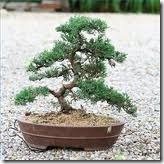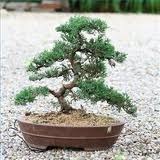 Bonsai are generally re-potted and re-pruned every few years. Re-potting prevents them from being pot-bound and encourages the growth of new feeder roots allowing the tree to absorb moisture more efficiently. You will also need to change the soil to prevent it from becoming stale and hindering growth.
Bonsai are generally re-potted and re-pruned every few years. Re-potting prevents them from being pot-bound and encourages the growth of new feeder roots allowing the tree to absorb moisture more efficiently. You will also need to change the soil to prevent it from becoming stale and hindering growth.
You can tell that a bonsai needs repotting if water takes a long time to drain through the soil or if the roots are crowding around the sides.
To repot, carefully lift the tree out of its current pot by tilting it to one side and trying to move it by the base of the trunk. You can not pull too hard on the trunk – so if this does not work, try tapping the pot with the side of your hand to loosen the root ball or poke a stick through the drainage holes and ‘push’ the root ball out.
Next, using a chopstick, knitting needle, metal hook or similar, remove any moss or accent plants and carefully try to brush and untangle the roots. Start at the edge and gradually work around. Try to ‘comb’ and ‘tug’ rather than to ‘pull’ at the roots – for risk of damaging or tearing some very important main roots.
After this has been done – continue to shake and brush off the soil until about one third to half of the original soil has been removed from the edge and base of the root ball.
It would now be a good idea to spray the roots with water to ensure that they do not dry out and so that they will not have too much soil on them when it comes time to pruning the roots.
To prune the roots, use very sharp cutters. There are bonsai root pruning scissors commercially available, however you could just use a normal pair of bonsai clippers.
If you have washed away most loose soil the scissors will stay sharp, but if they have to cut through soil as well as the roots – they will become blunt very quickly and require sharpening.
Start by cutting the thick, old brown roots that have come close to the edge of the pot and are restricting the growth of the young ‘feeder roots’. Remove a third to a half of these – being careful that you do not remove too many feeder roots in the process.
Next, prune the thinner roots which hang below the depth of the pot by trimming them all into a suitable shape that the pot will accommodate. This should be a shape that fits comfortably into the pot with a 1-2 cm (1/2 to 3/4 in) space between the edges.
The demanding part of the repotting is now over – if you think that you’ve cut too many feeder roots off, the tree will be disadvantaged but you probably will get away with it – as new roots will grow from the cuts.
Clean the original pot thoroughly or select a new pot that is more suited to the tree and cover the drainage holes with simple wire mesh. As the plant will now be unstable in the new pot as it has nothing to anchor it – you need to make some anchors to prevent the tree from falling over from winds or from being moved.
Thread some wire through the drainage holes or specially designed holes for anchoring and leave for later use. This wire doesn’t have to be very thick.
Add a thin layer of gravel to aid drainage and then a layer of soil. Moving the tree around, decide a basic position for it (usually off-center and slightly to the back of the pot) and make a small mound that it will sit on. Now you can place your bonsai on the mound by gently nestling it in and spreading its roots out evenly throughout on top of the soil.
Once you are happy with the height and position of your tree (it is going to stay like that for 1-2 years), take the wires that you threaded and twist them together (usually with the aid of pliers) over the main root ball of the tree until it is held firmly (but not too tight) and will not rock. Because these wires are quite unsightly, you can remove them in a few months time once the tree has settled in.
Add more soil up to the base of the trunk – which should be just below the base of the pot. Tap the side of the pot with your hand to ensure that the soil becomes settled and that there are no gaps around the roots. Use your chopstick to incorporate the roots into the soil and to make sure that they are placed correctly.
Once the soil has been applied, you now have the option to add supplementary features such as rocks, moss, accent plants or gravel to enhance the design. When applying moss – be careful that most of the original soil is cut off from the bottom before you plant it and that the moss is not too big or vigorous for the pot or tree.
Now you should thoroughly water the tree – being aware that the soil level may settle further and that more soil may have to be added. Place the tree in a position where it will not receive extremes in temperature (i.e. not direct sun) and where it will be able to recuperate. Do not fertilize at this time as this can burn or cause stress to the plant. You can feed in around a month though, when the roots have recovered.
Note that in order to balance out the extensive pruning you have just done on the roots you should prune the branches of the bonsai as well so that it can recover quicker and not be disadvantaged further. Root growth usually does equal branch growth.
Since bonsai is essentially meant to be grown outdoors, you must pay attention to the care of your tree with the changing seasons.

Deprecated: strpos(): Passing null to parameter #1 ($haystack) of type string is deprecated in /home/agriviek8Qv/agriviet.net/public_html/wp-includes/comment-template.php on line 2522